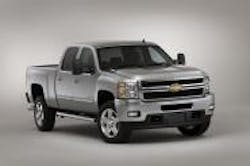“These historic new standards set ambitious, but achievable, fuel economy requirements for the automotive industry that will also encourage new and emerging technologies. We will be helping American motorists save money at the pump, while putting less pollution in the air.” –Transportation Secretary Ray LaHood
Even as the federal government cracks its knuckles and begins to contemplate how to set fuel economy mandates for medium- and heavy-duty trucks, it’s putting the final touches on such mandates for cars and light-duty trucks.
Yesterday, the Department of Transportation (DOT) and the Environmental Protection Agency (EPA) released their jointly established federal rules that set the first-ever national greenhouse gas (GHG) emission and fuel economy standards for all new passenger cars and light trucks sold in the U.S.
The DOT’s National Highway Traffic Safety Administration (NHTSA) and EPA set the new fuel economy standards under NHTSA’s Corporate Average Fuel Economy program and GHG emission standards under the Clean Air Act – and they will cover 2012 through 2016 model-year vehicles.
Both agencies believe these rules could potentially save the average buyer of a 2016 model year car $3,000 over the life of the vehicle and, nationally, could conserve about 1.8 billion barrels of oil and reduce nearly a billion tons of greenhouse gas emissions over the lives of the vehicles covered.
[You can read all the complicated mumbo-jumbo about this new rule by clicking here.]
Starting with 2012 model year vehicles, the rules together require automakers to improve fleet-wide fuel economy and reduce fleet-wide greenhouse gas emissions by approximately 5% every year. NHTSA has established fuel economy standards that strengthen each year reaching an estimated 34.1 mpg for the combined industry-wide fleet for model year 2016.
Because credits for air-conditioning improvements can be used to meet the EPA standards, but not the NHTSA standards, the EPA standards require that by the 2016 model-year, manufacturers must achieve a combined average vehicle emission level of 250 grams of carbon dioxide per mile. The EPA standard would be equivalent to 35.5 miles per gallon if all reductions came from fuel economy improvements, the agencies noted.
[Click here if you want to delve into the complicated technical analysis both agencies used to come up with those figures. Me, I don’t have enough Advil in the house to help me do that.]
Climate change is big bugaboo in all of this – something the EPA keeps referring to as “the single greatest long-term global environmental challenge” with almost breathless abandon – with cars, SUVs, minivans, and pickup trucks responsible for almost 60% of all U.S. transportation-related greenhouse gas emissions, according to the data compiled by these government agencies.
Again, DOT and EPA believe these rules should reduces carbon dioxide emissions by about 960 million metric tons over the lifetime of the vehicles regulated – equivalent to taking 50 million cars and light trucks off the road in 2030 – while conserving about 1.8 billion barrels of oil over the lifetime of the vehicles regulated.
Now, NHTSA and EPA expect automobile manufacturers will meet these standards through a variety of ways, such as using more efficient engines, transmissions, fuel sipping tires, aerodynamics, and materials, as well as the aforementioned improvements in air conditioning systems.
Although the standards can be met with conventional technologies, EPA and NHTSA said they also expect that some manufacturers may choose to pursue more advanced fuel-saving technologies like hybrid vehicles, clean diesel engines, plug-in hybrid electric vehicles, and electric vehicles.
It should also be noted that Canada is also announcing Light Duty Vehicle GHG-Emissions regulations today that mirror the ones now being established in the U.S. – and it should come to no one’s surprise that the U.S. EPA and NHTSA say they’ve worked closely with Environment Canada to “ensure a common North American approach.”
Well, there you have it – fuel economy improvements by government fiat. Will they actually deliver the intended results? That’s a discussion for another day.
